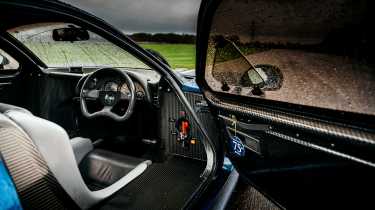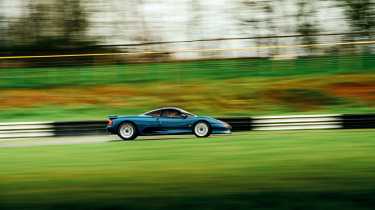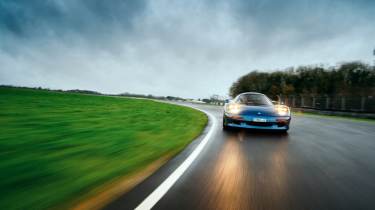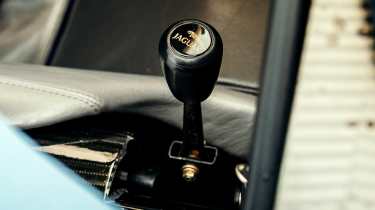Jaguar XJR-15 (1990-1992) review – TWR's Le Mans-winning V12 for the road
The oft-forgotten Jaguar hypercar cousin to the XJ220 has a Le Mans-proven V12 and a carbon construction. We drive it in the sopping wet on track
This time,’ I think, as I dash through the rain towards the XJR‑15, ‘perhaps I won’t put the headset on.’ Reaching the sleek, RAF-blue supercar I swing open the thin little door and then slide across about a foot and a half of sill and seat, slotting my lanky legs beneath the curiously shaped Nardi steering wheel as I slither in and shut out the weather. It’s an entry that’s easier described than done.
Once ensconced, I feel like I’m sitting almost centrally in the car, not far from the driving position of a McLaren F1. Visibility is great and, surrounded by an airy, rain-spattered bubble canopy, I’m reminded of another supercar: a Zonda. The amount of bare carbon is reminiscent of a Pagani, too, although there is a considerably rougher, more race-car finish to the interior, with an exposed roll-cage and small, flip-down triangle cutouts in the side windows for ventilation. Not so much jewellery box as tool box.
Of course, it’s entirely reasonable that it should feel a little raw because 15 is based on 9. As in, the XJR‑9 that Messrs Lammers, Dumfries and Wallace took to victory at Le Mans in 1988. The 15 was built to celebrate their win and it certainly gives the feeling of a feral racing car that has received only the rudimentary basics of house training. The XJR‑15 had its own competition career too, albeit a brief single-make championship. But more of that in a bit.
The seats are formed from what look like growths on the rear bulkhead and are therefore fixed like those in a LaFerrari or Gumpert Apollo. The grey leather-covered padding adds a surprising amount of comfort, but the four-point harnesses bring you straight back to thoughts of Le Mans. As would the matching blue headset if put on but, as mentioned, this time, just out of curiosity, I’m going to leave the cans clamping the small headrest behind me.
More reviews
Group tests
- Lotus Emira Turbo SE v Alpine A110 GTS – two of the last surviving mid-engined sports cars
- Alpine A290 v Alpine A110 – how much DNA do they really share?
- Ariel Atom 4R v Caterham Seven ‘evo25’: power-to-weight heroes go head-to-head
- Ariel Atom 4 v Caterham Seven 310R v Lotus Elise Cup 250
- £200,000 supercar shoot-out: AMG v Aston Martin v Maserati v McLaren
- Audi Quattro, RS2 and RS3: five-cylinder icons head-to-head
- Who makes the best GT car? Aston Martin v Bentley v Maserati
- Caterham Super Seven 600 v Super Seven 2000
- Corvette Stingray v Porsche Cayman GTS v Audi R8 RWD
- Great Ferrari hypercars driven: 288 GTO, F40, F50 and Enzo head-to-head
In-depth reviews
- Abarth 600e 2025 review – Italy gives the Alpine A290 something to worry about
- Alpine A110 review – the sports car Lotus should be building
- Aston Martin Vantage 2025 review – a thrilling Mercedes-AMG GT and 911 Turbo S alternative
- Audi R8 (2015 - 2024) review – the ultimate soft-focus supercar
- BMW iX 2025 review – the ugly duckling still stomps the Tesla Model X
Long term tests
- Abarth 695C Turismo Fast Fleet test – living with the charming Italian hatch
- Alfa Romeo Giulia Veloce Fast Fleet test – living with the sharp Italian saloon
- Alpina B10: Alpina B10: end of term report
- Aston Martin Vantage (2006) Fast Fleet test – living with a £30k V8 Aston
- Caterham Seven evo25 Fast Fleet test – living with a track car for the road
- Caterham Seven evo Edition revealed – bespoke 420R joins the Fast Fleet
- Cupra Leon 300 Fast Fleet test – living with Spain's 300bhp hot hatch
- Cupra Ateca VZN Fast Fleet test – four months with Cupra's hot crossover
- Cupra Leon Estate 310 4Drive Fast Fleet test – living with the 306bhp hot estate
- Ford Mustang GT
Review
- New Bentley Batur 2023 review – can it possibly be worth £1.65m?
- 2023 Chevrolet Corvette C8 Z06 review – the American 911 GT3?
- BBR Supercharged Mazda MX-5 (ND) 2023 review – tuned 250bhp roadster driven
- MG4 Trophy 2023 review
Reviews
- Abarth 695 75 Anniversario edition 2024 review – a fitting send-off for Abarth’s hot supermini?
- Abarth 500e 2023 review
- AC Cobra 378 Superblower MkIV 2021 review – another V8 Cobra, but with a GM heart this time
- Acura Integra Type S 2024 review – a Honda Civic Type R with added restraint
- Alfa Romeo Giulia 2025 review – get one while you still can
- Alfa Romeo 33 Stradale 2025 review – a rare Italian jewel beyond compare
- Alfa Romeo SZ: history, review and specs of an icon
A quarter twist of the big, red electrical cut-out switch, then flicks of the top three in a column of four toggle switches, labelled IGN, INJ and PUMPS. A whirring stirs behind. Then it’s time to toggle the last switch: START.
Generally, I’m not much of a one for swearing. Nuns are usually safe within earshot. But there are undoubtedly times for an impassioned expletive or two and as the monstrous sound of the 6-litre V12 hits my unprotected eardrums, I instinctively give it both barrels with the cussing. I genuinely feel myself flinch with a fleeting fundamental fear as the shockwave of angry engine noise erupts into the cabin. In fact it’s a good job I’ve got a harness on, otherwise I’d probably have hit the roof with the nervous recoil.
It is insanely loud. Blip the throttle and you’re consumed by the sort of slightly discombobulating volume of noise that actually makes it hard to think. With one of your senses almost overwhelmed it’s as though there’s not enough RAM left in your brain to run your other faculties and carry out simple functions. Like driving a supercar.
Had I not already driven the car, I would have undoubtedly put the headphones on at this point and let the squishy foam dampen the din and bring the world back into focus. But as I’ve already splashed around some exploratory laps of Castle Combe, I decide to persevere with the full-on aural assault for a lap or two.
Although chassis 21, like all 53 of the XJR‑15s, is a right-hand-drive car, it’s my right hand that selects first gear in the five-speed H-pattern. The stubby lever is set into a notch in the sill and the gate is tight and mechanical, but there is just enough movement laterally to make you feel sure of your selections.
The race cars got six-speed straight-cut ’boxes but road cars like this were given five-speed ’boxes with synchromesh in a nod towards civility. It is a pleasing shift, once it’s warm. The floor-hinged pedals are perfectly placed too, which also helps ameliorate the intimidation imposed by the engine.
There’s more reassurance once you’ve let in the clutch (plenty of torque to play with, thankfully) and encountered the first few corners. The steering wheel might have the aesthetic of a smashed tennis racquet, but there’s nothing broken about the feeling it imparts. Even in the wet there is plenty of feedback from the front tyres and as a result you feel happy leaning on the grip and even allowing the tread blocks to scrub across the surface a little, letting you know how hard you’re pushing the car early in the corners.
It’s always nice to have a progressive front end to work with, particularly when you feel like you’re sitting right up in the arrowhead of a car with a lot of weight behind you. And it’s really the mass of the XJR‑15’s big engine as much as its outputs (450bhp and 420lb ft) that makes this 1050kg car feel like it could be tricky. Like it could live up to its reputation…
Back in 1998, famous farmer Jeremy Clarkson decreed that the XJR‑15 was ‘the worst handling car of all time’. And that kind of accusation sticks like chewing gum to Velcro. To be fair, it wasn’t just Clarkson who was critical, because a number of the drivers who raced the competition versions of the XJR‑15 in its one-make series found it a struggle too.
The series was only three rounds long and seemed to come about as something of an afterthought. You see, the XJR‑15 wasn’t built by Jaguar. Look at the badge on the nose or the steering wheel and you will see the name Jaguar Sport. This was a subsidiary of TWR (Tom Walkinshaw Racing), who ran the Jaguar race team that won Le Mans in ’88. In fact Jaguar was none too pleased when it heard that Walkinshaw was planning a celebratory supercar that would be in direct competition to its own nascent big cat, the XJ220.
Walkinshaw assured a concerned Coventry that the XJR‑15 wasn’t in fact a rival at all and was only really being developed for a one-make race championship. A championship that it’s possible he only then went about setting up. Chicken or egg? The order of events seems to have been lost in the mists of time.
Anyway, all three rounds of the 1991 Jaguar Sport Intercontinental Challenge were support races during Formula 1 weekends and they sound like they were an absolute riot. The 16 cars mostly had professional hired hands behind the wheel and rubbing was very definitely seen as racing. After events at Monaco (won by Derek Warwick) and Silverstone (won by Juan Manuel Fangio II) it all came down to a showdown at Spa.
This finale was an extraordinary race because, as the grid set off towards Eau Rouge for the first time, none of the drivers knew how many laps they were in for. This was because it was a winner-takes-all event and the prize for first place was an enormous $1million in cash, and so, fearing a fix amongst the canny pros, the organisers had simply said the race would be at least six laps long. In the end, the chequered flag came out after 11 laps and touring car driver Armin Hahne took home the spoils.
I imagine there were more than a few racing driver excuses from those in his wake, but there does seem to have been a genuine issue with the tyres. Walkinshaw had done a deal with Bridgestone but the supplied rears weren’t really suitable and went off very quickly, leaving the drivers with something of an oversteering V12 handful. Hahne actually put his win in Spa down to having qualified with only one set of tyres, thereby saving a fresh set for the race.
The aerodynamics also seem to have been less than perfect, with the 15’s ride height too lofty to get the flat floor and big Venturi tunnels working properly, the resultant instability further adding to the reputation for wayward handling.
Certainly, sitting in the pitlane at Castle Combe the road car’s ride height doesn’t look ideal for any ground effects, but today the Spinal Tap noise levels and the puddles like public lidos on the circuit are of more immediate concern. The standing water means some unusual lines are necessary on a couple of corners and on the start-finish straight there is a little lump that unweights the rear axle just enough to prompt a fierce flare of attention-grabbing revs in fourth gear.
But that feedback through the steering really is good, and although there is more roll than in an F40, there is much less than in a McLaren F1 (the second all-carbonfibre road car after the XJR‑15). The engine too, although gruff and palpably potent in a bear-like, big-chested way, is also responsive and easy to manage thanks to being naturally aspirated. As such the whole driving experience feels more encouraging than it’s reputation had led me to believe and, approaching the long right-hander of Quarry, it feels like time to take the next step. I feel nervous but also somehow professionally compelled to tweak the tail of the £1.5million (£500,000 in 1991) tiger and see if the reality matches the cantankerous reputation.
With the front end loaded up and being teased on the edge of understeer I can feel the rear is also ready to move if provoked, so I dare to give it a bit more throttle. The 335-section back tyres unhook as easily as a coat on an overloaded peg, but there is no instant spin. In fact it feels reasonably controllable and I keep the small slide going for a moment rather than snapping back off the throttle. Admittedly, I’m concentrating intently and it’s certainly no lazy lockstops M3 drift, but it’s not horrible.
I give myself a lap to recover, refocus and then the next time round I get a bit more greedy. This time I have to quickly throw more steering at the slide, but still it doesn’t slip into the sort of whipping, lump-hammer gyrations that I feared it might. You can feel it sit into the oversteer and you can tell how hard the sidewall on the outside rear is working. It definitely requires respect and the following lap I’m content to keep everything nice and tidy, but knowing what’s over the limit means I now feel happier raising the pace and I can hustle it a little more through the rest of the corners.
The control weightings mean that it doesn’t initially give the impression of being as featherweight as its figures would suggest, but the more you drive it and delve into the dynamics, the more you feel the lack of mass. With no traction or stability aids to lean on, it isn’t a car that you can ever entirely relax with, but the unfiltered nature of it also means that its character is laid bare and so you can judge it more easily than more modern machinery.
With more laps you begin to appreciate the secure feeling of being snuggled between the sill and the big central bolster. As you trust the car more you revel in the fabulous visibility over the nose, the big single wiper swishing back and forth (controlled by the curiously chunky motorbike grip sprouting from the steering column).
Stretching the engine is interesting because it’s surprisingly linear and it’s easy to meter out the 6-litre’s raucous power. However, the flip side of this is that it doesn’t really feel like it crescendoes. Perhaps it’s just because it’s so loud all the time that nuance is drowned out, but it’s easy to think you’re short shifting when in fact you’re up towards the top of the revs and speed has built more quickly than you thought. The simple VDO speedometer, by the way, reads all the way up to 220mph – 5mph more than the claimed top speed, but perhaps a subtle dig at, nod to or just accidental acknowledgement of the other XJ supercar.
Really though, Jaguar needn’t have worried about the XJR‑15 being a competitor. For a start, it was built in tiny numbers – there were over five times the number of XJ220s produced. Even the McLaren F1 is exactly twice as common as the XJR‑15. Then there’s the fact that the XJ220 has a very different, much more refined character with a much broader appeal. In fact I can’t think of many road cars that are less refined than the XJR‑15.
It gets compared to the McLaren F1 a lot, because the two cars share a designer in Peter Stevens, both have big, naturally aspirated V12s and both have that lightweight all-carbon construction. But the end products of those ingredients are wildly different. The Jaguar Sport car is actually much more like a Porsche GT1 in terms of how tough and road-racer it feels. Although I think even the homologation car from Stuttgart would seem relatively refined after a drive in the XJR‑15.
It is, then, extreme. But I don’t think it is as flawed as legend would like us to believe. If it was, then I don’t think I would have enjoyed driving it round a sopping wet circuit in Somerset as much as I did. I was incredibly nervous beforehand, but it won me round and I was grinning broadly (not just with relief, either) every time I flicked off the toggle switches.
And it wasn’t only its dynamics that were a pleasant surprise; I loved looking at the pure, clean, elegant aesthetics of the car. Admittedly the rear lights (Mazda 6?) look a bit clunky but the rest is more gorgeously low, flowing and neat than I’d ever really appreciated. There’s a delicacy to it that belies the monstrous engine inside.
It’s a car that – once you’ve extricated yourself from it – you look back at as you walk away. If you owned one then I don’t think you’d make as many journeys in it as with some other supercars, but the ones undertaken would stay with you. Every drive would be memorable. My day at Castle Combe will certainly stay with me. And not just because of the tinnitus.
| Engine | V12, 5993cc |
|---|---|
| Power | 450bhp @ 6250rpm |
| Torque | 420lb ft @ 4500rpm |
| Weight | 1050kg (435bhp/ton) |
| 0-60mph | 3.9sec |
| Top speed | 215mph |
| Price new | £500k (1991) |
| Value today | £1,500,000+ |
This feature first appeared in evo 303














